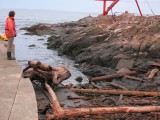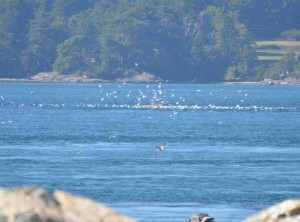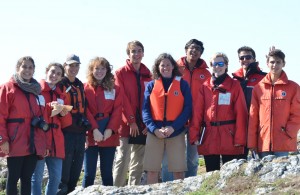It was a clear day from glorious sunrise to subdued sunset. The wind was 5 to 15 knots in the west – southwest quadrant and solar radiation was high, though not quite as high as yesterday; 400 Langleys today and just over that on Monday. As I write the Log blog, clouds are creeping in and blanketing the mountains on the American side and the barometer is falling again. Forecasts call for a switch to southeast winds, which usually brings wet weather. Wednesday is supposed to be increasingly cloudy and rain is supposed to follow.
Only eight commercial whale watching vessels were noted in the Ecological Reserve boundaries today and five of those were in the afternoon associated with Biggs (Transient) Killer Whales on the other side of Race Passage. The Killer Whales were on the Vancouver Island side of the passage and spent several hours in and around Bentick Island and Emdyck Passage and William Head. Several pleasure craft passed through the reserve today, all without speeding or fishing in reserve. There was one overflight during the first class field trip: a small fixed-wing aircraft that passed over west to east and then returned passing over a second time. Although one red flag was up all day at the military site there were no obvious explosions.
Pearson College students spent part of the day here today. Two of Laura Vehegge’s classes of marine science students came for their first field trip of the year to Great Race Island. I was hoping they would have a chance to see the Sea Otter, at least one pod of Killer Whales and maybe a couple of Humpback Whales, but no. After all they have just started a species list that they will be adding to for the next two years, so they will have other opportunities.
Today the students were also working on journal entries about their marine animal observations. They were lucky enough to see California and Stellers Sea Lions, Northern Elephant and Harbour Seals and lots of Glaucous-winged Gulls. There were also Mew Gulls, California Gulls and if they were sharp-eyed, Heerman’s Gulls. Those were the ubiquitous species, but for me, the more interesting and unusual species were two new, avian visitors that showed up today; a male and female Horned Lark. I send a shout out to Victoria Natural History Society on Twitter for helping with the identification. A flock of 24 Canada Geese landed and were on the island for a very short visit.
Laura’s classes witnessed the down-side of plastic in the ocean today. Is there an up-side? They had the ‘opportunity’ to observe three neck-laced sea lions. Those two California Sea Lions and one Steller Sea Lion with plastic straps around their necks will likely not survive long unless they get the specialized attention of Vancouver Aquarium veterinarian, Dr. Martin Haulena. Dr. Haulena has worked extensively with sea lions and is one of the few people able to do this sort of animal welfare work. This is another good reminder for all of us to avoid plastic if possible, recycle it and just in case it “gets away” cut all possible entanglers before disposing of it. There are a lot of really good efforts towards reducing plastic in our seas and there is a real need.
The Killer Whales mentioned above showed up late in the afternoon and missed both classes.
It was good to see Courtney with Year 20 volunteer Jasper, as a deck-hand on Second Nature. He had quickly graduated to skipper in training by the third run to Race Rocks.
-

-
Sea lions waking up with company.
-

-
Wall to wall sea lions.
-

-
Wall to wall from the tower.
-

-
Stellers Sea Lion with plastic strap on neck.
-

-
Female Horned Lark
-

-
Male Horned LArk
-

-
Male Horned Lark
-

-
Laura and Marine Science students from Lester B. Pearson College of the Pacific.
-

-
Laura, marine science students and visitors.























